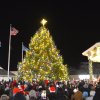Nick Carter: California dreamer returns to Lewes
Anyone who has lived in the Cape Region for more than a week would recognize Nick Carter – and probably have his phone number nearby.
As a successful Realtor, his name and face are everywhere, in newspaper ads, on the internet, billboards, flyers and listing signs. But, there is much more to Nick Carter than his professional life. He's seen action during the Vietnam War and was ahead of his time selling solar energy systems. At 50 years of age, he made a life-changing decision to move from one coast to another and start over.
His family has ties to Lewes that go back five generations, and as a third-generation U.S. Naval Academy graduate, he has strong military roots as well. His grandfather, Frank Saulsbury Carter Sr., served on battleships during World War I; his father, Frank. S. Carter Jr., served at Fort Miles during World War II; and Frank S. Carter III (Nick) served two tours of duty during the Vietnam War.
His grandfather started the Frank S. Carter Insurance Co. in Lewes in 1923 and built a home at 412 Bay Ave. on Lewes Beach. His mother, Elizabeth W. Carter, lives in another Bay Avenue house his father built.
His great-grandfather, William P. Carter, served on Lewes City Council in the late 1800s, and his great-great-grandfather, William Q. Carter, lived at the corner of Fourth and Market streets in downtown Lewes in the mid-1800s. “We lose track of the family ties after that,” Carter said. He has a photograph of his great-grandfather in front of his house on the beach in 1919.
Carter could write a best-seller filled with interesting stories about his family. The Market Street house where his grandfather lived – next to Bethel U.M. Church – still has an elk stag etched in glass on the front door. It is the symbol of the Hartford Insurance Co., the company he represented when he started his Lewes insurance company in 1923.
Strong connection to the sea
The family has always had a strong connection to the sea and sailing, we well as the Lewes Yacht Club.
His grandfather was one of the founding members of the Lewes Yacht Club in 1932, and he and his son were both commodores. Both men raced at LYC during the 1930s. His father won his first LYC race in 1932 at the age of 14 with crew Roland Marshall, who kept racing up until just a few years ago.
Currently serving as vice commodore, Carter stands in line to be a third-generation commodore this fall.
Carter began sailing at the age of 10 in the family Sailfish “Sea Star.”
“Challenged by the more experienced sailors, I learned soon enough to understand the currents and tides on Lewes Beach,” he said. Those early years set a foundation for a lifetime of sailing that continues today.
At the U.S. Naval Academy, he participated on the Navy Sailing Team for three years and won a varsity letter in 1968 sailing on the Shields boats and raced in the Shields Nationals. His sailing interests ventured from Hobie Cat racing, offshore racing to his ultimate adventure of sailing from Fiji to Australia on the Around the World cruising fleet in 1966.
Today, Carter, his wife Laurie and two children spend a lot of time sailing and racing aboard Delgato. Nick was instrumental in establishing the Cape to Cape Challenge – a sailing race from Lewes to Cape May, N.J. – each summer and starting weekly LYC fleet races every Wednesday night in the summer. He has also served as chairman of the LYC finance committee.
Daughter Annie, 7, and son Frankie,10, are following in the footsteps of their family as both will be entering their third year of sailing camp this summer at the yacht club. Frankie raced on Sunfish last summer and will be crewing on the family sailboat during the fourth annual Cape to Cape Challenge again this year.
It's time to go home
Carter was living in California when he decided it was time to come home. “I was turning 50 years old and my parents were 80 years old. I had been in California for 27 years and thought that was long enough. It was time for me to settle down, get married and have children,” he said.
“So I came to Lewes with no job and no place to live; I made a life-changing maneuver at 50 years of age,” he added.
He doesn't say that a certain young lady had also caught his eye on one of his trips to visit his parents.
His marriage 12 years ago to Laurie Draper joined two long-time Sussex families; the Draper family has Delaware roots dating back to the 1600s. And, yes, they do have a direct connection on their family trees. “It looks like we are related seven generations back,” he said with a laugh. “I've been here 15 years and things have worked out well; I'm very fortunate.”
He has a photo of Laurie's grandfather, Frank Draper, and his grandfather, Frank Carter Sr., posing together in a photo taken in 1964 at the Deauville (Fla.) Hotel. “They use to winter in Florida and would get together. When I saw that photo I knew it was destiny Laurie and I would be together,” he said.
A foundation rooted in the beach life
Growing up in Lewes in the 1950s and early '60s was a special time. “It would be hard to duplicate; I had a wonderful childhood,” he said.
He lived the beach life. Living on Bay Avenue right on the beach, the only time he and his friends went inside was to eat. He was sailing at 10, scuba diving at 13 and surfing at 14 years of age. Days were also filled with fishing, crabbing and spending time on his father's power boat. “We went barefoot quite a lot,” he said.
Carter walked along the beach to attend kindergarten at what is now the Children’s Beach House and then attended all 12 years of school at the Lewes School on Savannah Road, the same school his father graduated from.
During his senior year, Carter joined the Naval Reserves and attended prep school for one year before starting at the Naval Academy in Annapolis, Md. He was stationed in San Diego, Calif., which was the perfect place for him. “I loved California and was a big Beach Boys fan,” he said. “My wife said I went there because there were 'two girls for every boy,'” he joked.
After graduation, he served two tours in Vietnam aboard the destroyer USS Orleck in the Gulf of Tonkin, providing gun support to ground troops. The ship was also attached to the aircraft carrier USS Enterprise to aid in search and rescue missions for downed U.S. pilots.
Following the war, Lt. Carter returned to California where he taught anti-submarine warfare before leaving the Navy in 1975. He attended graduate school at San Diego State with the goal of becoming a certified public account with a master's degree in finance. “I did all of the course work but never got the degree because I can out of money and had to get a job,” he said.
Carter was ahead of his time. His master's thesis was on the marketability of solar energy in southern California, and he ended up working in the field into the early 1980s. In addition to working for another solar company, he started, and sold Alternative Energy Resources, a company that installed solar hot water heaters.
Carter knows better than most that timing is everything. He was a stock broker in the 1980s; the stock market collapsed in 1986 and he lost all his clients. He was a real estate broker in the early 1990s when the housing market bottomed out as the stock market boomed.
By the time everything cycled around, he was thinking about returning home to Lewes.
Carter's days are filled to overflowing with work, yacht club and family obligations, but he still finds time to help others when called on. When the Fort Miles Historical Association needed money – and needed it quickly – to cover the more than $100,000 cost to transport the USS Missouri gun barrel from Norfolk, Va., to Fort Miles in Lewes, they called on Carter and his wife.
Within six months, the committee had surpassed the goal; it's no wonder association President Gary Wray has wrangled him into staying on to continue to raise funds for the World War II museum housed in Battery 519 at Fort Miles.























































